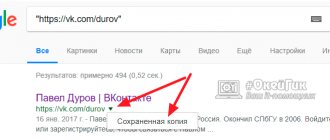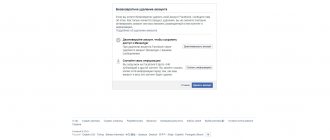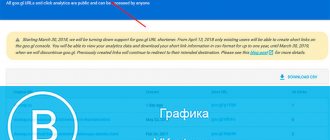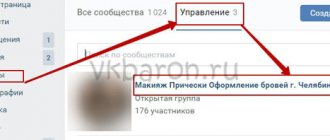Hello! I decided to write about blocking links on VKontakte after I once again encountered this phenomenon myself.
The thing is that in my group about making money on the Internet vk.com/rabotainet, on the right side of me there were published links to useful services where you can actually earn money for your work. I decided to check their performance. Clicked on them. But instead of moving to the desired service, I was redirected to a page where it was written that this was a “link to a suspicious site.” An explanation of this concept was also given there.
The social network vk.com itself only assumes that the link may lead to a site that deceives users and receives money for them. Of course, I didn’t write the explanation word for word, but in my own words. You can see the exact definition of “link to a suspicious site” in the picture below.
Why and what links does VK block?
If you cannot open a link in VK, there are reasons for this. More often we are talking about those sites and groups where they can deceive users, where a lot of complaints and blocks from users have been received. Here are some examples of why you can’t go to a page or post everywhere in VK:
- Deception and fraud, that is, the support service studies complaints and user reviews, checks the activities of the company or public, blocking it. A popular type of deception is phishing, when a copy of a website is created to obtain someone else’s data.
- The requirements of Roskomnadzor, that is, the community was included in the list of those objectionable to the state.
- Due to inappropriate or prohibited content, that is, 18+ publics.
- Lots of spam, mailings and advertising.
Method 3: Shortening the URL
You can avoid the “Link to a suspicious site” message right at the stage of publishing the address on VKontakte, thereby allowing other users to go to the desired resource without additional actions. To do this, you will need to shorten the URL using one of the special services.
Option 1: VKontakte
The social network VK itself provides a service that allows you to convert almost any URL into a short and, importantly, internal address. By using final link options, you can completely get rid of the problem in question. The procedure was described in sufficient detail in another instruction.
Read more: How to shorten VK addresses
Option 2: Goo-gl
Another online service that allows you to convert links is Goo-gl, which also provides a secure address with the ability to use it on VKontakte.
Go to Goo-gl home page
- Open the service's start page and add the full URL to the "Insert link here" text box.
- On the right side of the window, click the “Reduce” button and wait for the procedure to complete.
- You can select the final version from the same text field by selecting and pressing “CTRL + C”, or using the “Copy” button.
Unfortunately, this online service does not always guarantee that the problem will be resolved.
Option 3: U.TO
Perhaps the most reliable online service for creating links to bypass VKontakte verification is U.TO, which is completely devoid of the disadvantages of previous options and works reliably with any addresses. In terms of functioning, this site is not much different from similar solutions.
Go to U.TO main page
- On the main page of the online service, find the text field and paste the original link that you previously copied to the clipboard. To convert, you need to click “Reduce”.
- If the procedure is successfully completed, another field with a ready-made address option will appear on the screen. Copy this URL and try using it on VK.
- If errors occur during the conversion process, make sure you are using the full link, including the "http" or "https" prefix. Also, refreshing the page may help.
As you can see, the service is quite easy to use and is unlikely to raise any questions.
Option 4: Blogger
The last and most unusual way to shorten a full link for use on VKontakte is to use the Blogger site. This option is very different from the previous ones, but at the same time it provides greater versatility due to the ability to change the final address at any time.
Go to Blogger home page
Step 1: Registration
- Open the Blogger start page and click “Login” in the top right corner.
- After going to the Google login window, sign in using your account information or select an account you are already using.
- To complete, you will need to fill out the “Display Name” field as you wish and click “Go to Blogger.”
Step 2: Create a blog
- Having completed the preparation, you need to create a blog, which will act as a means of shortening the link. To do this, in your personal account, click on the arrow icon and select “New blog”.
- At your discretion, fill out the “Title” and “Address” fields in accordance with the resource rules. To continue, in the “Theme” block, select “Dynamic Preview” and click the “Create Blog” button.
- After successful creation, you will immediately find yourself in the blog editor. Here you need to go to the “Subject” page in the left column.
- Left-click on the gear icon under the “On Mobile” block and place a checkmark next to the “No, use the regular version” option.
- After saving using the appropriate button, on the “Theme” page, find the “Now on Blog” section and click “Edit HTML”.
- Scroll to the bottom of the code page and delete the text inside the “Script” tag.
- In place of the removed code, you need to insert the following so that the result clearly matches the screenshot:
window.onload = function() { document.location.href='External_link'; }; - Finally, change the "External_link" value to the original URL you want and click "Save Theme" in the top bar.
- You can get the final URL by copying the previously set blog address or by right-clicking on the “View blog” line and selecting “Copy link address”. Please note that if you are not satisfied with something, the URL can be changed in “Settings”.
Thanks to this approach, you can easily make redirects to external sites, ignoring the VK check. In this case, the method will be relevant only in rare cases, for example, if you need to maintain the same link in working order on an ongoing basis.
The methods presented throughout the article will allow you to get rid of the “Link to a suspicious site” message if you go to already published addresses and prevent the occurrence of errors in the future even at the stage of creating the URL. Each solution is quite safe, so choose it first based on the situation.
We are glad that we were able to help you solve the problem. Add the Lumpics.ru website to your bookmarks and we will be useful to you. Thank the author and share the article on social networks.
Describe what didn't work for you. Our specialists will try to answer as quickly as possible.
How to switch if VK blocks?
If you want to see the “forbidden” and follow a blocked link, then there are options. Let’s immediately clarify that it’s better to do this from a computer (more convenience and faster):
- Open Chrome, Firefox.
- Find the link you need.
- Press Ctrl+Shift+C.
- Point to the link, copy.
- The console will jump to the code.
- Double-click after the title.
- Copy the link.
- Paste into a new open window.
As you can see, it will be impossible to do this from a phone, and even a VPN will not save you.
Link shortening
Displaying a notification that the URL leads to a dangerous site is prevented by placing a shorter URL in the post. For this purpose, you can use the online service Goo-gl:
- In the address field on the main page of the site https://goo-gl.su, enter the full line of the shortened URL.
- Click the button called “Save” to start the address shortening procedure.
- When it finishes successfully, highlight the final result in the text box and click CTRL+C.
- Insert it when creating a publication on the VKontakte social network.
But the considered service is not always guaranteed to ignore the VKontakte protective transition, so you can use the following U.TO option. It works more efficiently with a variety of addresses, practically no different from its analogues. To shorten a hyperlink in this program:
- In a browser window, load the page at https://u.to, where you will need to find the text field.
- Paste the URL previously located on the clipboard and click “Shorten.”
- When the operation is completed successfully, another field will appear on the display with a completely completed result.
- Copy this address using the ctrl+c hotkeys, and then try to use VKontakte.[*] If the conversion is accompanied by errors, make sure there is a full link with the http or https prefix.
How to prevent VK from blocking?
Now let's talk about how to make sure that VK does not block links. There are three popular and effective ways:
- Redirect via Blogger.
- Domain rental in an affiliate program.
- Creating a personal redirect service.
We recommend spending a little time and money to avoid constant setup.
Now in order:
- In the first case, you need to register on the Blogger website, come up with a topic and title, disable the mobile template, make a link for an affiliate program, change the HTML, find , insert the code in the form of a modified VK link, then insert the second code, save the changes.
- In the second case, you need to rent a domain, 2domains is especially good, registration will cost about 100 rubles, they often have promotions and discounts. Register anywhere and you will receive newsletters about promotions and you will be able to choose the appropriate offer. The main thing is to enter the DNS server data after registering the domain and come up with a new name.
- The third way is to create a personal redirect service that you use yourself. You can even use free WordPress and the Pretty Link plugin to create one. After downloading everything to your computer, you need to go to create a new link, insert an affiliate program link in the target field, come up with a new host, click “Create” and everything will be ready.
Whichever method you choose, everything is configured via a personal computer, but not a tablet or phone. The process takes two hours, the second option will cost about 150 rubles, but the other methods are free and available to everyone. If you have difficulties setting up, there are a lot of training and step-by-step videos on YouTube.
There is an article on our website about how to bypass the ban on links in Telegram.
Bypass link blocking
In order to bypass the blocking, today we will register a new domain and put a redirect there to our referral link. I would like to warn you right away that we will register the domain absolutely free of charge. Yes, it’s free and the site freenom.com will help us with this. On this site you can connect a huge number of free domains. This method is quite simple and will take a minimum of time.
1) And so we go to the site freenom.com
2) Select the option to register a new domain in the menu
3) Then on the page that opens, enter the desired domain that we need in the field (I’ll take the testovii domain as an example) and check if it is available
4) After checking, a list of available domains appears. If this domain is not taken, then you can connect it for 12 months for free. You can select several domains or all available at once (if you need it). Click the Get it now button! , opposite the domain you chose, then click Checkout
5) On the next page, open the drop-down menu and select the domain connection period (up to 12 months free) and click the continue
6) Then we will be asked to enter data (they must be real. For example, the index must match the specified region, etc.). If you are not registered yet, then enter your email and confirm it. Check the box and click Complete Order
If you did everything correctly the following page will appear
7) Then go to the “my domains” section and go to the settings of the domain you need (from which you need to make a redirect) (A redirect is a redirect)
 Select the menu item that you see in the screenshot
Select the menu item that you see in the screenshot
9) Then indicate your referral link and select “redirect”, press the blue button.
If you did everything correctly, then within an hour your link will work and you will be able to use it in VK or other places, and most importantly, it will not be blocked.
Let's sum it up
When a group or public conducts honest activities, they do not encounter the problem of blocking. This means that you won’t need all these complex settings or domain rental. If you are a simple layman, then a couple of clicks in the console will open any site or page, although more often you don’t need to do this. Since in 90% of cases we are talking about real scammers or prohibited content. But we all suffer from curiosity, so give it a try.
Read further:
Link to a channel in Telegram: where to look for it and how to use it?
Tips on what to do if your Odnoklassniki page is banned?
How to bypass Telegram blocking on PC?
“This video is not available” - what does such a message mean on YouTube?
"You shall not pass!" or how to bypass the ban on links in Telegram
[Total: 2 Average: 5/5]
Author of the publication
offline 3 years
Copy-paste addresses
The problem of blocking hyperlinks is circumvented using standard web browser tools. To this end:
- Download the official VKontakte website, and then select the problematic address.
- Press the hot keys ctrl+c so that the line appears on the clipboard.
- Load a new tab, then left-click the address field and press ctrl+v.
- Press the Enter button to open the page of the requested web portal.
Another method allows you to bypass protection against accessing suspicious sites using the browser console. To display its window:
- Place the cursor on the selected line and click the right mouse button.
- In the list of available commands that appears, select “ View code ”.
- Load the Elements tab, where you need to find the block with the URL and click the data-external-url parameter.
An alternative method suggests that you obtain a hyperlink directly from the page showing the notification in question, using an address sequence of characters. To do this, simply copy the domain name without the http or https prefix.
What are the dangers of shortened links and how to protect yourself from them
Short links are a great tool. Sometimes we run into a problem where we need to display an extremely long URL while still making it look neat and professional. In other cases, short URLs are used to ensure that the total number of characters in a message does not exceed the maximum allowed by social networks. Short links are needed to make the Internet easier to use. Did you know that there is a flip side to the coin and that URL shortening does more harm than good?
How attackers use short URLs
The most effective way to distribute malware is through links.
Wandering around the Internet, we see links everywhere, both on websites and in news feeds on social networks. A variety of files are distributed using links, and attackers take advantage of our willingness to click on any link to distribute malicious sites and files that we will go to when we click on the next link. But it's not that simple: a link won't be distributed if it's clear from the URL that it could lead to the download of a potentially malicious file. Say there's a picture or a website all you want, but if everyone can see that the link leads to an .exe file, no one will click on it. The secret is to make sure these URLs go undetected. Hackers resort to a variety of tricks: placing a link on a page overloaded with information, hoping to stumble upon those who click on links indiscriminately, hacking accounts and sending links to friends, believing that such a source will automatically be trusted, they even fake URLs so that it seems that the link leads to another page. Short links make an attacker's job easier because they hide where the user is actually going.
Why are short links dangerous?
Let's look at an example and choose an innocent victim - Google. Here's the website URL: www.google.com
Here's what a direct link to the Google logo looks like:
The difference is obvious. In the first case we see a link to the site, in the second - to the image. Once you read the URL, you will immediately understand where you will go and what you will see when you click on the link. Now let's try to follow the links through Bit.ly and compare the results. Is the difference obvious in this case? Let's take a look: bit.ly/1dNVPAW
- link to
www.google.com bit.ly/1JcI49O
- link to
Now the difference is not so obvious, is it? All that changes is a random set of letters and numbers after the “bit.ly” domain. The file extension is no longer visible and there is not even a hint of where the link will lead. Using these links, it is impossible to understand which one leads to the Google site and which one leads to its logo. And if we didn’t know in advance that bit.ly links lead to the Google website and an image of its logo, then we wouldn’t have the slightest idea what these links were.
This is exactly what attackers can take advantage of to distribute a malicious website or code. They can give a short link, assuring that it leads to a funny clip or some amazing news, and no one will understand from the URL that the link actually leads to a malicious file or site.
How to recognize them
So, you may come across short URLs online and you don't know how to check that they will take you to a legitimate site.
Is there any way to check the link without clicking it and make sure there is no malicious intent? Fortunately, there are several web services designed to combat these types of attacks. Below are some examples.
CheckShortURL is a great tool that covers most URL shortening services. Enter a short URL and CheckShortURL will analyze and tell you where the link goes. The service allows you to preview the site to ensure its reliability. If you have any doubts about the security of a site, CheckShortURL can automatically search for the site in various security assessment services, such as Web of Trust.
GetLinkInfo is suitable for those times when you want to find out what exactly is happening in the forwarding process. When clicking on a short link, users are redirected to a predefined address. The GetLinkInfo check allows you to see what steps a redirect goes through so you can be sure you're going to a secure site when you click on a link. GetLinkInfo also uses Google Safe Browsing technologies to evaluate security.
Additionally, some URL shortening services understand that there is value in giving users a behind-the-scenes look. Some of them offer a method to verify the links generated on their site so that users do not have to take risks. For example, did you know that if you add a “+” to the end of a bitly link, you will be taken to a preview page before going to the file or site itself? Try it yourself with one of the links above, for example: https://bit.ly/1dNVPAW+.
Always at the address
Short URLs are used to distribute malware, which means you should be vigilant when clicking on unfamiliar links provided by unknown people.
Now you know how short links are used by hackers and how to check whether a link is safe. Have you ever been caught off guard by a shortened link? Or are you suspicious of all short addresses? Tell us in the comments.
HOSTING.cafe will always help you choose virtual and dedicated servers, hosting and other services.











